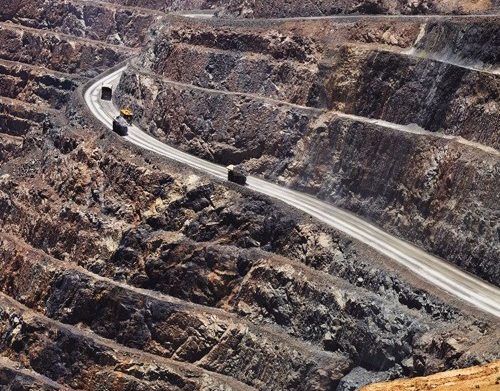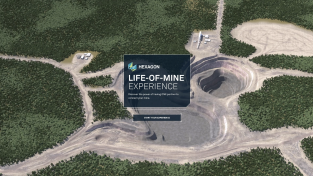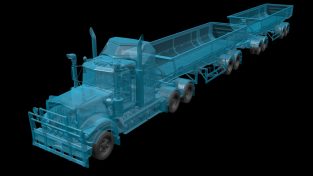Hexagon Mining President, Hélio Samora, explains how the company’s solutions are helping customers to build a digital strategy built on real-time connectivity across all operations.
BK: Welcome to HxGN RADIO. My name is Brian and thank you so much for joining us today.
We are discussing how Hexagon Mining is helping customers to make sense of their data by building a digital strategy built on real-time connectivity across all operations. Hexagon President Hélio Samora visits customers worldwide, sharing the company’s vision of a digital mine where intelligence is embedded in visualisation enabled for smarter decision making, reduced costs, improved safety and increased productivity.
I am here today with Hélio Samora, president of Hexagon Mining, and in today’s episode, we will be exploring the digital mine. Thanks for joining us.
HS: Morning, Brian. It’s a pleasure to be here.
BK: So tell us a little bit about what you are doing with Hexagon Mining.
HS: Okay, so first, who is Hexagon Mining? We are one of the vertical businesses inside Hexagon. The main purpose of the company is to provide all technologies that help mines to be more productive. and safer. The company was put to together in 2015, and I joined the company back then to integrate all the technologies we had acquired in the past.
The idea is from the day someone starts to plan a mine … from the number of years they operate the mine to the day they shut down the mine, they have technologies from Hexagon. So that was the vision put behind a single life-of-mine partner, a technology partner of mining. That was the vision that built Hexagon Mining. We really start when they start exploration, to the day they shut down the mine and return [the land]as close as possible to the original state.
BK: Excellent, excellent.
HS: That’s our main purpose of the company.
BK: Yes, now how long have you been in your role?
HS: Two and a half years, roughly. That was when the company was put together.
BK: Okay. Excellent. And I assume you are enjoying it and having fun with it, cause you’re doing a great job.
HS: We are doing very well in terms of profitability, growth, all those business KPIs. I think the company is very happy that we are doing mining. But the customers, more important, are happy with the technology. That’s the reason they continue to invest in Hexagon technology.
BK: Excellent. Now I know you are travelling around and visiting the mines and visiting the workers. What sort of challenges, common challenges, have you been hearing?
HS: That’s a great question. Miners today, they have two main goals. Reduce cost of production and increase safety. They are very well related because if there is an accident, miners will stop work and the cost of production will go up. So they are very connected. The miners are doing everything they can to produce more, in a safer way. Saving people’s lives, saving the equipment investment – those are the main goals I hear every single meeting I go to. So we are helping miners to follow that path with our technology.
BK: Excellent. Now how are you tackling some of these challenges?
HS: In terms of reducing costs, we do have several solutions that help the customer plan better their daily work. It will maximise the potential extraction of the ore. But we also have automation solutions that accelerate production. What is happening in mining today already happened in manufacturing many, many years ago when automation came in, so mines are trying to maximise the use of the assets. Things like reducing one minute per operation and 40,000 operations per month represents 40,000 minutes and a cost of a minute around 35 dollars – you would imagine how much money they can save per month. Saving one single minute, per load in those tracks. So every second counts in mining, time is very important in mining.
BK: Yes.
HS: So then there’s mining going for this automation process and we are well positioned to deliver technology for that. While our fleet management solutions have the best optimisation in the industry, we are helping miners to produce more. On the other front, safety. We do have the most robust technology for collision avoidance in the industry.
We have a 360-degree view that allows the drivers of those gigantic trucks to locate themselves related to all the vehicles around. And then we know that [our collision avoidance system](CAS) saves lives. On top of CAS, we abuilt several solutions like fatigue monitoring. We have a system called fatigue monitoring that monitors the operator’s behaviour and our alarms alert if there is a potential fatigue event.
So it’s another solution we have. We are now extending the solution to protect people surrounding the vehicles. We call this a personal protective system. So not only assets, but also people will be protected through our technologies.
BK: Excellent. And we’ve heard some of that in some of the other episodes as well, and it’s been really impressive to hear some of the solutions that you have around safety. And also saving time, which is fantastic. So, excellent! Now what’s your strategy in terms of the digital transformation in the industry?
HS: It’s also a big trend in mining today. Mines collect every day, terabytes and terabytes of data. From multiple sensors that exist today in mining. The tracks have sensors, bio sensors, fuel sensors, speed control, collision avoidance sensors provided by us. The mines have survey equipment radars collecting LiDAR – hundreds of sensors, hundreds of systems collecting big amounts of data every day.
But the mines have started not to use the data, and now the digital transformation is really looking into the day, understanding patterns, understanding standards that can be re-produced and remove the complexity of the business. Simplify operations, optimise the operation so the digital transformation is not only selling a software automation solution, but to collect all these data, make sense of the data and help the mine operate better and no longer in silos.
A mine is naturally a combination of siloed information. [Our] power strategies help the customer break the walls of those silos and make sense of the data they already have and transform this in directions and actions to optimise the business.
BK: Excellent. Now, we talked about safety earlier.
Tell us a little bit more about HxGN Mine VIS.
HS: The evolution of our collision avoidance system. We just launched our vehicle intervention system (VIS). Our vehicle intervention system is a next level of security, safety in case the operator doesn’t react to a CAS alarm. The system in certain situations will take control of the vehicle. Reducing the speed, activating the surface break or even preventing the vehicle to move.
BK: Sure.
HS: Today safety, as I had mentioned, is one of the key ingredients of a mining business. This is a demand from the industry, and in a few countries, it is now mandatory by law that the mine is investing in such technology. We are the first company to launch a VIS solution in the market. And we are very happy; we already have a customer that committed to the solution, AngloGold Sishen Mine in South Africa, a division of Anglo American Kumba Iron Ore. It will be the first mine on the planet using a vehicle intervention system solution, our first customer in this field as well. But it is really a level of safety that the industry does not have today, but is required in a few countries already.
CAS saves lives. But in case of, for some reason the driver doesn’t react, the operator doesn’t react to the CAS alarm. That will be an accident.
BK: Yes.
HS: With this, there will be no accident. As our advertisements say, ”Accidents stop here.” So this is really the next level of safety for mining operations.
BK: Well, it’s great to have, you know, additional precautions in place, which is great. HS: In case the driver … if he reacts late to an alarm, the system will protect the life of the operator and also the asset, which is huge.
BK: Absolutely huge. So, you are also releasing your reverse guidance solution. Tell us about that and how it works.
HS: Okay. Reverse guidance solution is our second step towards our alternate strategy. Your car or some of the cars already in the market today have this similar capability, which is to guide the driver, guide the operator to park the truck in the right position.
It’s a human-assist solution and that would remove a lot of costs from mining. Parking a car in reverse has some challenges. But parking a vehicle that is a size of -story building, it’s three times more difficult to park. Then what happens in the mine every day are thousands and thousands of re-spot. Re-spot means the driver missed the load position and needs to move forward.
Reverse again. Every minute counts, as I mentioned before. So there is a metric that we calculated with a real customer here in U.S. They lose $200,000 per week with re-spot costs – $200,000 a week multiplied by 50 weeks minus a 24-hour operation, you can imagine how much money you are talking about.
BK: Absolutely.
HS: Time lost and production lost with re-spot incidents. So the reverse guidance will eliminate this loss of time, because it’s going to help the driver park in the right position for the load. So it is a great solution will be released in the second half of this year. But it’s ready for few trials now and we expect to have customers to ready to embark in that technology in the next few months.
BK: Excellent. So do you know what sort of time is expected to be saved in that autonomous parking?
HS: I don’t have exactly the number.
BK: Sure. Sure.
HS: But I would say per fleet of 50 trucks. Let me give you some metrics for a fleet of 50 trucks; it’s about one hour per day.
BK: Okay.
HS: Per truck.
BK: Yes, wow! That’s a lot, that’s fantastic.
HS: Because you have a lot. It’s not easy, as I mentioned, to drive a truck that is a size of a building. So drivers have limited visibility, and then if they miss the point of load, they’re going to need to move forward and reverse again. So this piles up hundreds and hundreds of times, that is where the money goes.
BK: It’s a great solution.
HS: As mining looks to save seconds, minutes are gigantic numbers.
BK: So are there any other benefits? You’ve listed off quite a bit of benefits already, that the autonomous technologies are going to be helping with. Any other benefits that we haven’t covered?
HS: Reverse guidance is the second stamp into our autonomous program. This is going to really accelerate operations and in the future, we will have upgrades for the next features of our autonomous programs, auto-steer/auto-spot. That is very similar to what some cars have, that you approach the parking space hands off, press a button and the vehicle parks itself. So that’s exactly why we are having with our next semi-autonomous functionality.
BK: Excellent. Very exciting and also very helpful. Well, Hélio, thank you very much. Anything else you want to share before we wrap up?
HS: Just to finalise in terms of autonomous, Hexagon is providing semi-autonomous and autonomous solutions for mining. The VIS was the first step, reverse guidance is the second step – auto-steer, auto-spot, short-term delivery, and then we will deliver full autonomous late next year to the industry.
So the industry is going to autonomous or semi-autonomous solutions. Hexagon Mining is committed to delivering to customers the best autonomous solutions in the industry.
BK: Excellent. All right, well, thank you very much for sharing all of this. You can go to hexagonmining.com as well to check that out, but thank you for your time today.
HS: Thank you, Brian. Thank you for having me here.
BK: Absolutely. Be sure to tune in to more episodes on hxgnradio.com, or you can go to iTunes, SoundCloud, or Stitcher, if you would like. Thanks for joining us. Have a wonderful day!

















